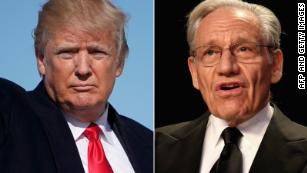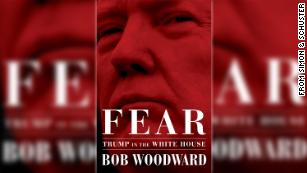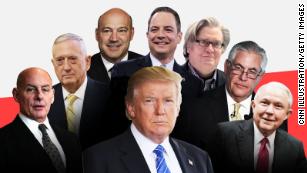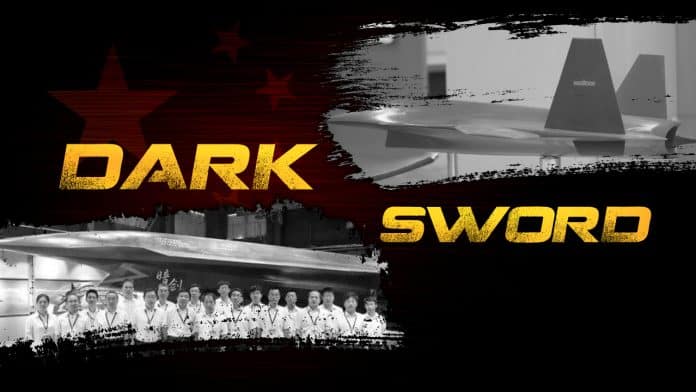13 totally bananas moments from Donald Trump's phone call with Bob Woodward
President Donald Trump called The Washington Post's Bob Woodward. Trump had heard Woodward was working on a book and called to ask why Woodward had never reached out to him. Woodward told Trump he had repeatedly tried to reach him through official and unofficial channels and been rebuffed. He also informed the President that the book -- "Fear: Trump in the White House" -- was done (it comes out on September 11) and that Trump was too late.
1. "It's really too bad, because nobody told me about it, and I would've loved to have spoken to you. You know I'm very open to you. I think you've always been fair."
Trump is right -- Woodward is fair -- but the President saying this on tape(!) makes what undoubtedly will be the White House's attempt to discredit Woodward that much tougher. Also, it becomes clear time and time again in this phone call that people -- including White House counselor Kellyanne Conway and South Carolina Sen. Lindsey Graham -- did talk to Trump (or his scheduling team) about sitting down with Woodward, even if the President says he didn't know it.
2. "Madeleine is the key. She's the secret. Because she's the person...."
Trump is talking about Madeleine Westerhout, his personal assistant. And her being "the key" is no longer much of a secret.
3. "Well, a lot of them are afraid to come and talk, or -- you know, they are busy. I'm busy. But I don't mind talking to you. I would've spoken to you."
The President of the United States is acknowledging that many of his aides are afraid of him! That. Is. Nuts. Also, Trump reiterates here that he would have been more than happy to talk to Woodward.
4. "And I certainly don't mind talking to you, and I wish I could've spoken to you. But nobody called my office. I mean, you went through, I guess, different people. ..."
Put a pin in this. We'll come back to it.
5. "Who were the senators? No, they never called me about it. ... Senator Graham actually mentioned it quickly in one meeting."
In between Trump saying no senator mentioned it and him admitting Graham mentioned it comes this line from Woodward: "Senator Graham said he had talked to you about talking to me. Now, is that not true?" What happened is this: Trump made a sweeping statement. Woodward called him on it with a fact. Trump acknowledged his previous statement (seconds before)was inaccurate. Good times. (Also, see No. 4.)
6. "So I have another bad book coming out. Big deal."
This can be read either as false bravado (Trump is trying to convince Woodward that nothing can really hurt him with his supporters) or actual bravado (Trump is convinced that nothing can really hurt him with his supporters). I'm honestly not sure which it is.
7. "I mean, you do know I'm doing a great job for the country. You do know that NATO now is going to pay billions and billions of dollars more, as an example, than anybody thought possible, that other presidents were unable to get more?"
This line from Trump comes DIRECTLY after Woodward describes the way in which he used sources and described meeting in the White House. It's almost as if Trump turned on some sort of autopilot function. Because in the context of the conversation, the decision to tout your work on NATO makes a total of 0% sense.
8. "Well, other than Lindsey [Graham], who did quickly mention it, nobody mentioned it."
Um, no. Scroll down. (Also, see No. 4.)
9. "Nobody told me about it. Well, let me ask her. Why don't you speak to Kellyanne. Ask her. She never told me about it."
Trump hands the phone to Conway at this point. (I told you this was an amazing phone call!)Conway, with Trump listening, says this: "I put in the request. But you know, they -- it was rejected. I can only take it so far. I guess I can bring it right to the president next time." Then she adds: "I try to follow all the protocols, or else I'm accused of being somebody who doesn't follow protocol." Conway's shade here at the team who handles Trump interview requests is truly epic. Look, I asked. They said no. Talk to them.
10. "If you would've called directly -- a lot of people are afraid ... Raj, I hardly have ... I don't speak to Raj."
Raj Shah is the principal deputy communications director at the White House. He's running point for the confirmation of Brett Kavanaugh to the Supreme Court. He's also likely had better days than today.
11. "She should've come to me. She does have access to me. Absolutely. She has direct access, but she didn't come to me."
That thud was Trump pushing Conway under the bus while on a taped phone conversation with a political reporter.
12. "I'm just hearing about it. And I heard -- I did hear from Lindsey, but I'm just hearing about it. So we're going to have a very inaccurate book, and that's too bad. But I don't blame you entirely."
Here's where you begin to see Trump formulating what will be his spin about "Fear." I didn't even know about the book. Some of my aides didn't tell me. So the book is wrong. The problem there is a) Woodward has a long track record of getting it right and b) Trump casting himself as someone his aides are afraid to tell stuff to isn't a great look for him.
13. "Well, accurate is that nobody's ever done a better job than I'm doing as president. That I can tell you."
Remarkable. Woodward is assuring Trump that the book will be factual and accurate. Trump responds by showing he seems to have no idea what those words mean -- offering an opinion about how great he is doing as president.
The battle lines have been drawn. On one side, President Donald Trump and his allies and enablers. On the other, Bob Woodward, hundreds of hours of taped interviews and dozens of sources and a book that reads as a comprehensive indictment of Trump's first 19 months in office.
Trump spent Tuesday attacking Woodward's "Fear: Trump in the White House" as largely a work of fiction containing "so many lies and phony sources." (Notably, he didn't detail the alleged lies. More on that below.) Woodward, meanwhile, is largely letting the reporting in the book speak for itself.
Continents and regions
Donald Trump
Eastern Europe
Europe
Government and public administration
Government bodies and offices
Investigations
John Kelly
Political Figures - US
Politics
Russia
Russia meddling investigation
US federal government
White House
"I stand by my reporting," Woodward told CNN's Jamie Gangel.
So where do we go from here? Below, five storylines to watch over the coming days that may well determine who winds up with the upper hand in the fight over "Fear."
1. Can Trump disprove anything of consequence in the book?
What we saw late Tuesday was a series of coordinated denials by senior Trump staffers -- chief of staff John Kelly and Defense Secretary James Mattis -- designed to rebut hugely damaging portrayals of them as both afraid and dismissive of the President. But statements like those are sort of de rigueur in these situations. Broad denials that create straw men, knock them down and then suggest the matter is settled. If Mattis and Kelly didn't put out statements doing just that, it's hard to see how they could possibly remain in the administration for even one more day.
But what now? Trump tweeted Wednesday morning that the Woodward book "form[ed] a picture of a person that is literally the exact opposite of the fact." That is a big claim. Given Woodward's reputation -- as the preeminent chronicler of the modern White House -- and his long track record of fair and accurate reporting, the onus is on Trump to prove Woodward made major mistakes. And that means providing specific evidence of mistakes, not just saying the book is riddled with errors.
2. Will Republicans break ranks?
Time and again over his first year-plus in office, Republican elected officials have sought to ignore or downplay Trump's repeated unpresidential words and actions. They have played along with his construct that nothing is his fault and everything is the fault of the media and the way we cover him. Do Republican influencers keep up that solid front in the face of what -- knowing Woodward -- is almost certain to be a mountain of evidence (transcriptions of interviews, tapes etc.) that back up his book? Already, less than 24 hours in, cracks were showing. On Tuesday night, South Carolina Sen. Lindsey Graham called Woodward a "good reporter." And Ari Fleischer, former press secretary in the George W. Bush White House and someone who has demonstrated a willingness to defend Trump, tweeted this: "I've been on the receiving end of a Bob Woodward book. There were quotes in it I didn't like. But never once -- never -- did I think Woodward made it up. Anonymous sources have looser lips and may take liberties. But Woodward always plays is straight. Someone told it to him." The issue is not whether the Jeff Flakes and Ben Sasses of the world criticize Trump; they will. What matters is whether any of the leadership of the party -- or other members who have not previously voiced their issues with the President -- do so.
3. What else does Woodward have?
Remember that the actual book doesn't come out until next Tuesday. Yes, we've already heard some of the juiciest nuggets. But, this is a 400+ page book. Which means that there is a lot more in there. What is it? How does Trump react to it? How is it covered -- and for how long? The initial wave of Woodward stories is over. But the overarching story isn't done -- far from it. How long it goes and how bad it is for Trump depends heavily on what else Woodward has in the book and/or other damning audio like the sort he released yesterday of a recorded phone call between himself and Trump.
4.Will the White House message change?
Trump is a notoriously unreliable messenger -- often saying one thing in an interview and contradicting himself in a tweet. Or offering a totally different version of events than the official White House readout of a situation. Remember how Trump fired then-FBI Director James Comey because of a memo that Deputy Attorney General Rod Rosenstein wrote? And then Trump admitted to NBC's Lester Holt that he was going to fire Comey regardless of the memo, while thinking "of this Russia thing with Trump."
We're already seeing some message dissonance from Trump. After spending most of Tuesday night and Wednesday morning disparaging the Woodward book as fake, Trump tweeted this at 9:20 a.m.: "Almost everyone agrees that my Administration has done more in less than two years than any other Administration in the history of our Country. I'm tough as hell on people & if I weren't, nothing would get done. Also, I question everybody & everything-which is why I got elected!" That sure as hell sounds like a confirmation that the rough treatment by Trump toward his staff as described in the Woodward book is accurate. Which raises the question of whether Trump actually thinks Woodward's book isn't true, is true in parts or is totally true and he's just saying stuff.
5. Will there be a big resignation or firing?
I know that, at the moment, the White House is keeping a (mostly) united front. But we know that Trump and Kelly especially have not always been on the best of terms. Despite Kelly's denial that he called Trump an "idiot," it seems likely -- given not just Woodward's reporting but the weight of all of the reporting on this White House -- that Kelly has used a choice word (or 10) to describe the President. And it's also likely that Woodward has the tapes -- or transcripts -- to back up the claims he makes about how Kelly and Mattis view the President. When that rubber meets the road, it's possible that Trump loses his patience (he's done it before!) and jettisons someone like Kelly. Such a move would obviously, create its own spinoff storyline.





